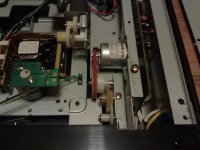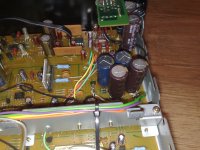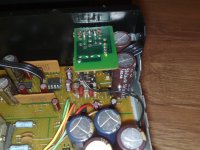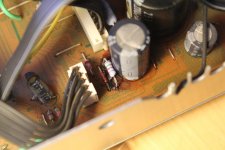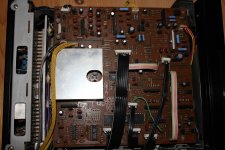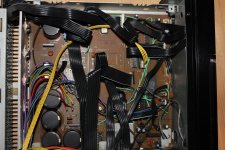Thank You for answer. Where is the best access to the loading motor belt? My DP1000 probably needs a lubrication. The movements of the tray aren't smooth. Could You specify the lubrication points?
The problem is opening the tray. I must turn the cogwheel (left to the marker - blue triangle). There is the resist in the first stage of movement. The open/close button must be pressed approximately 2 sec, unless the tray draws back. In open position the tray doesn't stop but draws back immediately.
What do You think about?
Regards,
f.
The problem is opening the tray. I must turn the cogwheel (left to the marker - blue triangle). There is the resist in the first stage of movement. The open/close button must be pressed approximately 2 sec, unless the tray draws back. In open position the tray doesn't stop but draws back immediately.
What do You think about?
Regards,
f.
Turn player upside down.
Remove front right and left screws from bottom panel.
Loosen the remaining nine screws and slide the bottom panel towards the rear until screw heads are released by the slots and remove bottom panel.
Tray loading motor is on right hand side.
Fit new belt or if your lazy like me, two rubber bands of an appropiate size.
Refit bottom panel and try.
If all is fine, pour one large drink, put favourite disc on, kick back and enjoy!
Hopefully photos will show what I mean and also some of the re-capping I've done.
Remove front right and left screws from bottom panel.
Loosen the remaining nine screws and slide the bottom panel towards the rear until screw heads are released by the slots and remove bottom panel.
Tray loading motor is on right hand side.
Fit new belt or if your lazy like me, two rubber bands of an appropiate size.
Refit bottom panel and try.
If all is fine, pour one large drink, put favourite disc on, kick back and enjoy!
Hopefully photos will show what I mean and also some of the re-capping I've done.
Attachments
Last edited:
Even if the belt looks in good condition the chances are that it has stretched and doesn't keep in tight contact with the pulleys.
Under these circumstances it will slip and fail to pull the magnetic disc clamp free from the disc motor support, inverting the player would I imagine give the help of gravity.
There is also somewhere a small micro switch which detects the opening and closing of the draw and the contacts inside can tarnish with age and none use. This gives the problem of the draw opening and immediately closing again.
Use of a contact cleaner may be required or if your lucky a dozen or so open/close movements can be enough for the internal contacts to self-wipe.
Can you see any signs of belt rubber around the pulleys in the grooves?
A sure sign of worn and stretched belts.
Under these circumstances it will slip and fail to pull the magnetic disc clamp free from the disc motor support, inverting the player would I imagine give the help of gravity.
There is also somewhere a small micro switch which detects the opening and closing of the draw and the contacts inside can tarnish with age and none use. This gives the problem of the draw opening and immediately closing again.
Use of a contact cleaner may be required or if your lucky a dozen or so open/close movements can be enough for the internal contacts to self-wipe.
Can you see any signs of belt rubber around the pulleys in the grooves?
A sure sign of worn and stretched belts.
Thank You for answer. I inspected the belt carefully. It looks like new - smooth and tense - not stretched or dried-up. It's hard to take off. No signs of rubber on the pulleys. I must clean the belt and the pulleys and see this mechanism working in normal position.
And what's about lubrication? What do You suggest? Could You specify the lubrication points and the kinds of grease?
f.
And what's about lubrication? What do You suggest? Could You specify the lubrication points and the kinds of grease?
f.
Try turning the pulleys with your fingers with the plug removed from the mains socket and see if there's any excessive resistance.
On mine all that was needed was a belt and a tiny bit of white grease on the cogs of the mechanism.
I suppose the grease on yours could have dried out and the teeth on the gogs be gummed up.
When you say the belt is hard to take off, did you actually remove it?
If not make sure that it's not stuck to the pulleys, I've had this occur on a cassette deck which refused to fast forward.
On mine all that was needed was a belt and a tiny bit of white grease on the cogs of the mechanism.
I suppose the grease on yours could have dried out and the teeth on the gogs be gummed up.
When you say the belt is hard to take off, did you actually remove it?
If not make sure that it's not stuck to the pulleys, I've had this occur on a cassette deck which refused to fast forward.
You are right. The original belt was not stretched, but the silicone rubber hardened. I changed the belt to the new one (common rubber). The tray works fine now.Even if the belt looks in good condition the chances are that it has stretched and doesn't keep in tight contact with the pulleys...
Thank You for advices. Best regards,
f.
I have there 990SG which is the same minus one power transformer. There are no fuses to check which would be an easy fix. I have seen electrolytic capacitors short out but not with these older Kenwood's since they use high quality Elna's. Anyway still check them for leaking and bulging tops. Resistors that supply the voltages if they are open can act like a fuse. Check your voltages from the discrete voltage regulator sections. Sometimes if your lucky you can find the problem using your nose "burnt smell". It is possible to have a bad transistor or two in one of the DC voltage regulator circuits that supply the processor IC circuit.
This is the glue used to secure the larger caps. It is corrosive and can corrode component leads and break away and loose conductivity you would have to remove the capacitor since you can't see the leads and check other component leads near the caps. With all vintage equipment over 20 yrs. old electrolytic capacitors should be replaced anyway. Over time the electrolyte becomes dry and looses its specs which can affect it to perform properly. Before you replace anything check your AC voltages first at the power transformer primary it should read anywhere between 100-240V AC. If you have higher voltage on the primary and nothing on the secondaries then the transformer primary windings are open and therefore the transformer is bad. It is possible to have a bad power switch but because its a CDP and not a power amp its not likely since it draws little current (I). Always check your voltages first and go from there.
- Status
- This old topic is closed. If you want to reopen this topic, contact a moderator using the "Report Post" button.
- Home
- Source & Line
- Digital Source
- Trio (Kenwood) DP-1000, Any info?
